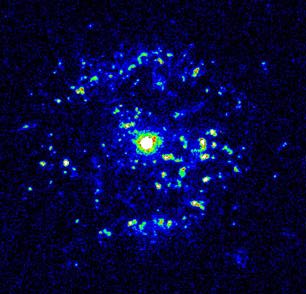The standard theory for novas is quite different from what the Ball-of-Light Particle Model predicts what a nova is. The Ball-of-Light Particle Model predicts novas are caused by a massive object -- e.g., a planet, a comet, or another star -- orbiting a star in a very elliptical orbit. As the object reaches perihelion -- its closest approach to the star -- the core of the star ejects induced balls-of-light that escape from the surface of the star's envelope of plasma and explosively decay. It is the sudden increase in the decay of ejected balls-of-light that suddenly increases the stars apparent luminosity.
As an example,

This is a Hubble Space Telescope close-up image of a Nova. Around the central star are thousands of ejected balls-of-light. These balls-of-light are decaying in various methods: the slow fizzle, the split, and explosively.
(See also, Jupiter, Gravitational Induction of an Electromagnetic Wave on a ball-of-light)
Because of the nature of an elliptical orbit, the Ball-of-Light Particle Model predicts that Novas will suddenly brighten and slowly darken. The Ball-of-Light Particle Model predicts the decay of the secondary balls-of-light will release x-rays and gamma rays and nonthermal radiation from areas around the star that can not be explained with the classical view of star formation.
The Ball-of-Light Particle Model predicts that a massive stellar impact that penetrates the outer plasma envelope and collides with the inner ball-of-light core could cause the core to decay in a more violent type of nova.
The Ball-of-Light Particle Model predicts the secondary decay objects will have strong enough electromagnetic fields on their surfaces to induce larger than normal atomic nuclei -- larger than hydrogen nuclei.
The Ball-of-Light Particle Model predicts that a violent enough nova will rip away the outer envelope of material exposing the core ball-of-light. Such cores are called White Dwarfs.